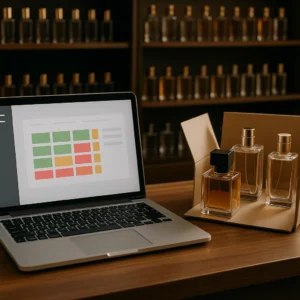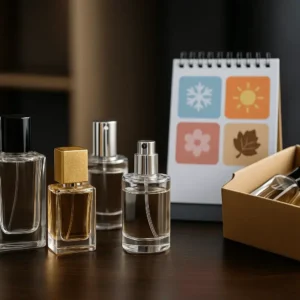Have you ever faced a busy sales season only to find your best-selling product marked “out of stock”?
In the world of perfumes, a seasonal stockout isn’t just an operational hiccup—it’s lost customers, lost revenue, and damaged reputation! A savvy retailer doesn’t leave peak seasons to chance; they plan for them just as meticulously as they would a new perfume launch.
In this Jasmine article, we introduce you to the most effective perfume inventory management strategies for your perfume shop. We’ll show you how to prevent overstock and delays, ensuring your products are available precisely when your customers expect them.
Stay tuned…
Why is Inventory Management Essential for Perfume Stores?
Inventory management is a cornerstone of any successful perfume shop, as it directly impacts product availability, profitability, and customer satisfaction.
Here are the key reasons why effective inventory control matters:
- Prevent Stockouts During Peak Seasons: High-demand periods—such as holidays, Ramadan, or New Year’s—drive surges in fragrance sales. Smart inventory planning ensures you have the right products in the right quantities when customers are ready to buy.
- Reduce Costs from Excess Stock: Holding oversized inventories can lead to product spoilage or wasted storage space. Precise stock management helps you balance ordering quantities with turnover, cutting unnecessary carrying costs.
- Boost Customer Satisfaction and Loyalty: When your best-selling scents are always in stock, customers know they can rely on you—and they’ll keep coming back for more.
- Make Data-Driven Decisions: Tracking every SKU’s movement and analyzing sales trends lets you pinpoint top-performing fragrances and phase out slow-movers, optimizing your assortment for maximum returns.
- Streamline Your Supply Chain: Accurate demand forecasting and timely reorders reduce logistical errors and ensure a seamless flow of products from supplier to shelf.
Neglecting inventory management in a sensitive market like perfumes isn’t just an oversight—it risks losing an entire season’s revenue. Treat your stock control as a strategic asset, and invest in it to secure your success.

Major Issues Facing Perfume Shops
Face seasonal challenges head-on—they’re more than just high-sales periods; they test your ability to manage supply, storage, and smart marketing.
Here are the top seasonal hurdles perfume retailers encounter:
Stockouts at Peak Demand
- Occurs often during holidays, Ramadan, and New Year’s.
- Leads to immediate lost sales and dents your brand reputation.
Inventory Buildup After the Season
- Over-ordering for peak periods leaves you with unsold seasonal stock.
- This ties up cash flow and drives up storage costs.
Supply-Chain Delays Under Global Pressure:
- Shipping or production disruptions during peak times can postpone fragrance or bottle availability, jeopardizing on-time delivery.
Sudden Shifts in Buying Behavior:
- Some scents spike in popularity overnight—driven by influencer campaigns or gift trends—making demand forecasting a real challenge.
Pressure from Seasonal Promotions & Discounts:
- Competing on price can erode your profit margins if discount strategies aren’t carefully modelled on accurate data.
Operational Strain Under Sales Volume:
- A surge in orders demands extra manpower and logistical coordination, exposing system weaknesses if you’re not prepared.
Solving these challenges starts with smart planning, precise inventory control, and seasonal sales data analysis—so you stay steps ahead of the market, not behind it.

Inventory Management Strategies for Peak Seasons
Implement flexible, intelligent inventory strategies during high-demand periods—effective planning ensures you stay in stock without overordering, minimizing waste, and maximizing sales.
Here are the top strategies:
- Analyze Historical Season Data: Leverage past sales reports to forecast demand accurately and identify your top-selling SKUs.
- Segment Inventory by Priority (ABC): Classify products into A, B, and C categories—focus on keeping your “A” fragrances (highest movers) consistently in stock.
- Place Pre-Orders with Suppliers: Coordinate early with your vendors to secure the quantities you need and avoid delays caused by seasonal surges.
- Allocate Emergency Stock: Maintain a reserved percentage of key products as safety stock to handle unexpected spikes in demand.
- Sync Inventory with Sales & Marketing Campaigns: Monitor promotions and anticipate their impact on stock levels, ensuring your supply matches your marketing push.
Also read: How to Start a Wholesale Perfume Business & Is It Profitable?
What are the modern techniques of inventory control?
Leverage smart technologies that boost operational visibility and minimize human error, such as
- Cloud-Based Inventory Systems: Provide real-time, accurate tracking of stock levels and product status.
- Demand-Forecasting AI: Enables proactive, data-driven decisions using seasonal sales analytics.
- Barcode Scanning & POS Integration: Simplifies daily inventory movement monitoring and links it directly to actual sales.
Adopting these solutions not only saves time but also gives you comprehensive control—reducing losses and multiplying sales opportunities during peak periods.
How do you manage inventory levels to prevent stock-outs and overstocking?
Balance availability and turnover intelligently by:
- Accurately forecasting demand through analysis of past seasonal data and customer behavior.
- Establishing minimum and maximum stock levels for each item to ensure timely reordering.
- Using rolling reorders (Rolling Reorders) to distribute quantities in smaller batches instead of one large order.
- Maintaining continuous communication with suppliers to secure rapid replenishment when needed.
Monitoring slow-moving SKUs to prevent inventory bloat with underperforming products.
This way, you guarantee your most sought-after fragrances are always in stock without turning your warehouse into a financial burden.
Also read: How to Conduct Perfume Business Feasibility Study 2025

Jasmine: The Perfume Factory You Can Rely On Anytime
Choose the powerhouse behind the success of perfume brands—Jasmine Factory, the manufacturer that fulfills your needs, whatever and whenever they arise.
With a network of over 70 agents worldwide and deep expertise in bulk perfume and freshener bottling, we offer a supplier who isn’t swayed by seasonality and never lets you down during peak demand.
Whether you’re a budding retailer or an established fragrance house, depend on Jasmine at every stage—from design and production to delivery—with unwavering quality, on-time performance, and robust supply capability even in the toughest conditions.
Jasmine… a name you can count on, every season, in every market.
FAQs about Perfume Inventory Management
How to run a perfume business?
Start with a clear plan that includes choosing the right location, designing an interior that reflects your brand identity, curating a fragrance assortment to match your target audience’s tastes, training sales staff in experiential selling techniques, and integrating your POS with inventory management to monitor performance and optimize decisions.
What’s the difference between regular stock and seasonal stock?
- Regular Stock: Fragrances that sell steadily year-round, like classic bestsellers.
- Seasonal Inventory: Products tied to specific periods—Ramadan editions or New Year releases—that require careful planning to avoid excess inventory once the season ends.
How do I choose reliable backup vendors for my shop?
Look for suppliers who deliver on time, maintain consistent quality, and have sufficient production capacity to cover emergencies. Test them with small trial orders first, and negotiate flexible agreements that guarantee rapid replenishment without cumbersome contract terms.
When to prepare for seasonal inventory for my perfume shop?
Begin 8–12 weeks before the season starts. This gives you enough time to analyze past demand, liaise with suppliers, secure the necessary quantities, and align your marketing campaigns.
What are Overstock Vs Understock?
- Safe Stocking: A calculated extra buffer to prevent stockouts during peak periods, based on real sales data.
- Costly Overstocking: Ordering well beyond actual needs, which ties up cash, increases storage costs, and risks product spoilage or obsolescence.
How to Balance Variety and Inventory Management?
Apply the 80/20 rule: focus on your top 20% best-sellers, and limit slow-moving fragrances. Introduce new scents in small batches, then monitor performance to decide whether to reorder or discontinue.
How often should you do an inventory count a Year?
Perform a full stocktake at least quarterly, with quick monthly checks on fast-moving SKUs. During peak seasons, increase the frequency of counts to prevent shrinkage and keep data fresh.